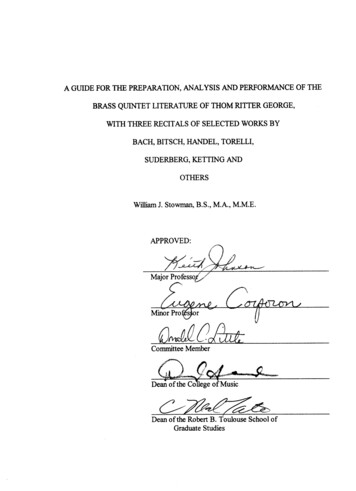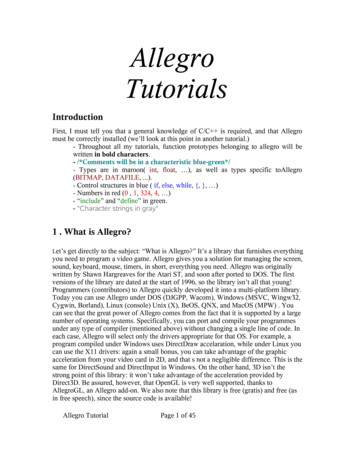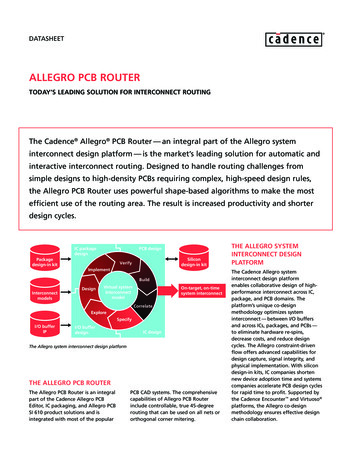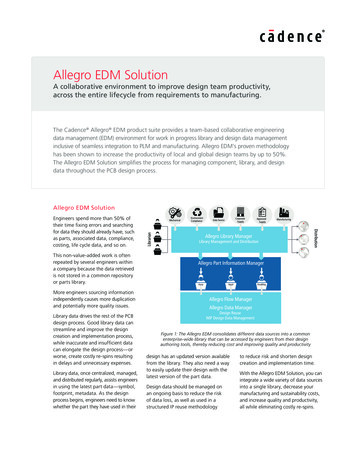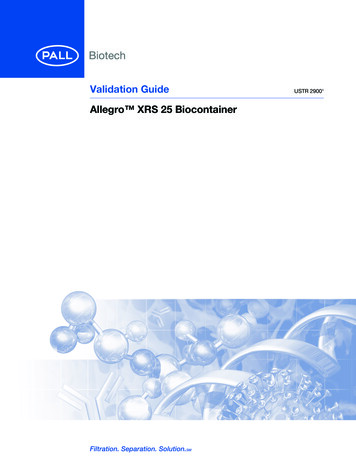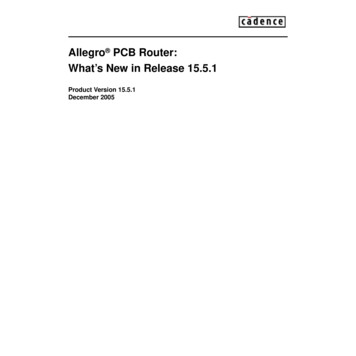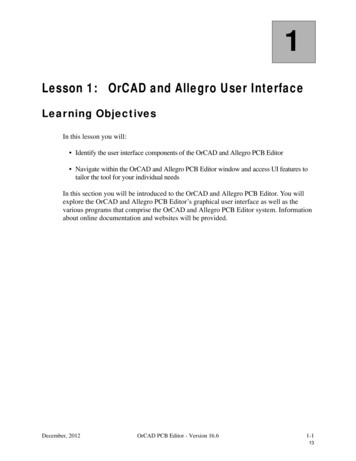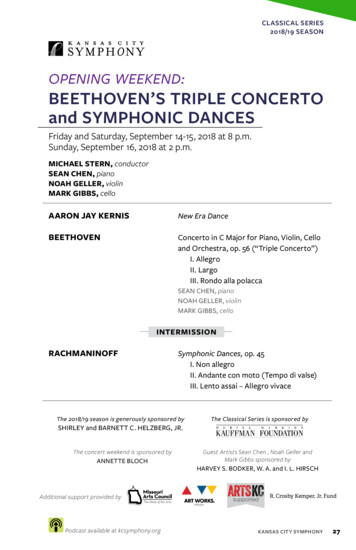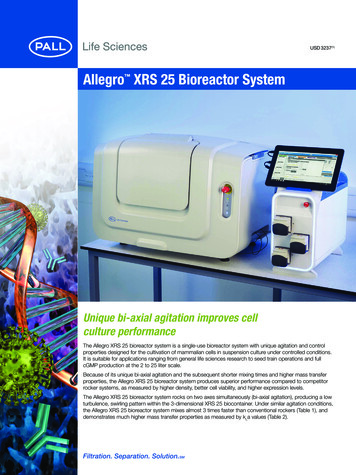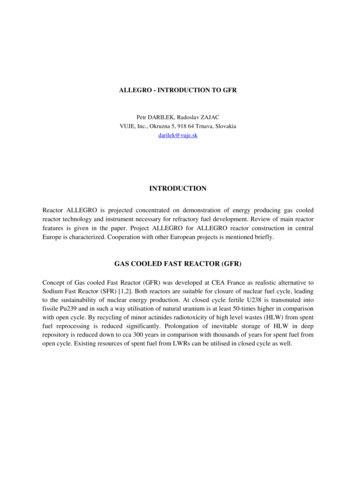
Transcription
ALLEGRO - INTRODUCTION TO GFRPetr DARILEK, Radoslav ZAJACVUJE, Inc., Okruzna 5, 918 64 Trnava, Slovakiadarilek@vuje.skINTRODUCTIONReactor ALLEGRO is projected concentrated on demonstration of energy producing gas cooledreactor technology and instrument necessary for refractory fuel development. Review of main reactorfeatures is given in the paper. Project ALLEGRO for ALLEGRO reactor construction in centralEurope is characterized. Cooperation with other European projects is mentioned briefly.GAS COOLED FAST REACTOR (GFR)Concept of Gas cooled Fast Reactor (GFR) was developed at CEA France as realistic alternative toSodium Fast Reactor (SFR) [1,2]. Both reactors are suitable for closure of nuclear fuel cycle, leadingto the sustainability of nuclear energy production. At closed cycle fertile U238 is transmuted intofissile Pu239 and in such a way utilisation of natural uranium is at least 50-times higher in comparisonwith open cycle. By recycling of minor actinides radiotoxicity of high level wastes (HLW) from spentfuel reprocessing is reduced significantly. Prolongation of inevitable storage of HLW in deeprepository is reduced down to cca 300 years in comparison with thousands of years for spent fuel fromopen cycle. Existing resources of spent fuel from LWRs can be utilised in closed cycle as well.
GFR have important advantage in comparison with SFR. Generated high temperature helium offersattractive applications as follows: production of hydrogen with efficiency at least 60 % (cca 25 % at classicalelectrolysis)coal gasificationfeeding of energy demanding technologies – production of steel, ethylen, styren, .electricity production with efficiency up to 48 %development of new high-temperature technologiesRecent parameters of proposed GFR industrial unit are as follows: thermal power 2400 MWthhigh power density 100 MW/m3cooling by He under 7 MPa pressure and with output temperature cca 850ºCrefractory carbide fuel with SiC/SiCf claddingefficient electricity production by indirect combined cycle with 3 gas and 1 steamturbinesspecific decay heat removal loops and guard containment for Helium capture duringaccidents
ALLEGRO – GFR DEMONSTRATORALLEGRO is low power GFR reactor without electricity generation, dedicated to demonstration ofhelium cooled high temperature fast reactor technology [3,4,5]. Pf special interest are developmentand verification of refractory fuel and verification of reliable removal of decay heat after shut downwith loss of pressure.Two different types of core loading are planned: starting MOX core, that enables to test operation of GFR technology with wellestablished fuel and simultaneously to test carbide fuel assemblies at 6 dedicated corepositionsfull carbide fuel core for broad test of new fuel design and GFR technologyCarbide fuelplatespinsTwo types of refractory carbide fuel are taken into account – in the form of plates and in the form ofpins. Main parameters of ALLEGRO cores with 3 different fuel types (MOX with steel cladding,carbide plates and carbide pins) can be seen in following tables. The highest He output temperaturescan be reached with carbide plates. Problems with leakage of fission gases require metal liners in SiCmatrix plates and pins.
Main characteristics of ALLEGRO 75 MWth MOX core (1/2)ALLEGRO MOX CorePower(MW)75Power density (MW/m3)100Operating helium pressure (MPa)7Core Helium inlet/outlet temperature ( C)260/530Fissile Core mass flow rate(kg.s-1)53.5Fuel form(U, Pu)O2 pelletsFissile core height (m)0.86Fissile core diameter (m)1.12Fissile core coolant fraction(%)37.5Pu/U Pu(%)25Global power peaking factor1.54Number of fissile S/As81Main characteristics of ALLEGRO 75 MWth MOX core (2/2)ALLEGRO MOX CoreNumber of absorber S/As (shutdown control rods)10 (4 6)Number of in core steel/experimental S/As6/0Number of reflector S/As174Cladding and reflector materialFuel S/A15-15 Ti steelPins within hexagonal tube metallic structureNumber of fuel pins per S/A169Pin pitch(mm) under cold conditions (mm)Under hot conditions (mm)7.937.98Pin diameter (mm)6.55Cladding thickness(mm)0.45Maximum cladding/fuel temperature ( C) in normaloperating conditionsTotal S/A length including spike and head (m)Core pressure drop (bar) (hot channel)562/96340.84
Main characteristics of ALLEGRO ceramic plate core (1/2)ALLEGRO ceramic plate corePower(MW)75Power density (MW/m3)100Operating helium pressure (MPa)Core Helium inlet/outlet temperature ( C)Fissile Core mass flow rate(kg.s-1)Fuel form7400/90028.1(U, Pu)C pellets in SiC matrix platesFissile core height (m)0.89Fissile core diameter (m)1.12Fissile core coolant fraction(%)22.7Pu/U Pu(%)Global power peaking factorNumber of fissile S/As[29.5; 35]1.4687Main characteristics of ALLEGRO ceramic plate core (2/2)ALLEGRO ceramic plate coreNumber of absorber S/As (shutdown control rods)10 (4 6)Number of reflector S/As174Reflector materialZrCFuel S/APlates within hexagonal SiC structureNumber of fuel plates per S/A15Plate thickness(mm)8.4Clad thickness (mm)0.85Internal liner (μm)Fuel pellet diameter(mm)Maximum cladding/fuel temperature ( C) in normaloperating conditionsTotal S/A length including spike and head (m)Core pressure drop (bar) (hot channel)40 10 50111012/129040.5
Main characteristics of ALLEGRO ceramic pin core (1/2)ALLEGRO ceramic pin corePower(MW)75Power density (MW/m3)92Operating helium pressure (MPa)7Core Helium inlet/outlet temperature ( C)Fissile Core mass flow rate(kg.s-1)Fuel form400/80036.1(U, Pu)C pellets with SiC claddingFissile core height (m)0.86Fissile core diameter (m)1.12Pu/U Pu(%)27.5Global power peaking factor1.43Number of fissile S/AsNumber of absorber S/As (shutdown control rods)8710 (4 6)Main characteristics of ALLEGRO ceramic pin core (2/2)ALLEGRO ceramic pin coreNumber of reflector S/As174Reflector materiaZrCFuel S/APins within hexagonal tube SiC structureNumber of fuel pins per S/A90Pin pitch(mm)11Pin diameter (mm)9.10Cladding thickness including liners (mm)1.08Cladding material (mm)SiC/SiCfInternal liner thickness40μ (W - 14%Re) 10μ (Re)External liner thickness30μ (SiC/SiCf provisionally)Maximum cladding/fuel temperature ( C) innominal operation863/1140Total S/A length including spike and head (m)4.20Core pressure drop (bar)0.36
ALLEGRO core is suggested with 6 experimental channels, 6 control and 4 shutdown rods andreflector. Control rods with relatively complicated drivers are inserted from the bottom of the core.Core designShutdown and reactivity control system
Produced energy will be thrown away into atmosphere except cca 10% for hydrogen productiondevelopment. Typical for ALLEGRO layout are decay heat removal exchangers, placed well abovemain pressure vessel because of safety reasons.ALLEGRO flow diagramDecay heat removal system
.ALLEGRO projectALLEGRO project includes all phases, necessary for GFR technology demonstration by ALLEGROreactor [6]: preparatory phaselicensing and construction of ALLEGRO reactorR&Doperation of ALLEGROdecommissioningInitial preparatory phase should provide basic documents, that can facilitate key decisions as follows: whether GFR is accepted in Europe as a complementary option of SFR whether the corresponding governments are ready to host ALLEGRO in the region selection of the site of the ALLEGRO reactorBasic documents will cover all specifications, analyses, studies and data necessary for construction,operation and dismantling of ALLEGRO reactor: General specification of the ALLEGRO projectLicensing roadmapPreliminary designPreliminary safety analysisSpent fuel management strategy, analysis of required servicesPreliminary analysis of environmental impactSite studies, criteria of siting, rules of the site selection processR&D in the licensing & construction and in the operational phaseGovernance, financing analysis, identification of potential partnersRepresentative institutes from three central European countries joined their effort for the project(confirmed by Memorandum of Understanding): Nuclear Research Institute, Řež, Czech Republic UJV, MTA KFKI Atomic Energy Research Institute, Budapest, Hungary Nuclear Power Plant Research Institute, Trnava, Slovakia – VUJEMain technical support is provided by CEA France, that have developed ALLEGRO concept andalready have started transfer of know how to project participants. Company AMEC from Great Britainwill contribute to the project as well and institutes from Poland are recently in the position ofobservers.Timing is suggested as atory phaseLicensing&construction phaseOperation of the ALLEGRO reactorDecommissioning phase
CONTRIBUTING EU FP7 PROJECTSThree EU FP7 project can support the ALLEGRO project.Project GoFastR – european Gas cooled Fast Reactor is oriented itself on development of gas-cooledfast reactor. Main challenges in the project are connected with development of refractory fuel for operation at fast neutron flux, high temperature and powerdensity, decay heat removal during loss of flow and loss of coolant faults.Project ADRIANA – Advanced Reactor Initiative And Network Arrangement concentrates onmapping and gap analysis of research infrastructure in support of the European Sustainable NuclearIndustrial Initiative. Project covers all three reactor technologies recently of interest – SFR, GFR andLFR.Proposal of project PALOMMAA – Properties And Laws Of Mox for Myrrha, Astrid and Allegro isdedicated to the fuel data for licensing of EU Gen IV fast reactor start up MOX cores. Scientificobjectives of the project are as follows: update of European catalogue of properties of MOX fuelidentification of missing dataperformance of experimental work programmeCONCLUSIONGas cooled Fast Reactor was featured shortly by main advantages and main parameters. ALLEGROreactor as demonstrator of GFR technology was characterised including planned development of thecore. Project ALLEGRO of three central European countries with support of CEA, targeted on reactorconstruction, was described. Supporting EU FP7 projects were mentioned.Future of ALLEGRO project and reactor depends on economical support from governments of threecentral European countries and from EU.REFERENCES[1] Jacques Rouault: The Gas-cooled Fast Reactor (GFR)Objectives and basic design features, ALLEGRO meeting with Central Europe Consortium(AEKI, UJV, VUJE) – February 11th, 2010 – CEA Saclay[2] P. Richard - Y. Péneliau - M. Zabiégo: Reference GFR 2400 MWth core definition at start ofGOFASTR, Deliverable D1.1-1, CEA/DEN/CAD/DER/SESI/LC4G DO2 26/03/10[3] Christian POETTE: GFR Demonstrator ALLEGRO Design Status, GFR/ALLEGRO , SACLAY,February 11, 2010[4] Gérard COGNET, János GADÓ: Ideas on ALLEGRO, General Assembly meeting of theHungarian Nuclear Society,Budapest, May 19, 2010[5] C. Poette, N. Alpy, C. Bassi, F. Morin, S. Dardour, F. Bentivoglio, N. Tauveron: ALLEGRO 75MW system definition at start of GOFASTR (Deliverable D1.2-2),CEA/DEN/CAD/DER/SESI/LC4G/NT DO XX du JJ/MM/AA[6] ALLEGRO PROJECT PREPARATORY PHASE ROADMAP, august 2011
ALLEGRO is low power GFR reactor without electricity generation, dedicated to demonstration of helium cooled high temperature fast reactor technology [3,4,5]. Pf special interest are development . Typical for ALLEGRO layout are decay heat removal exchangers, placed well above main pressure vessel because of safety reasons. ALLEGRO flow diagram.
